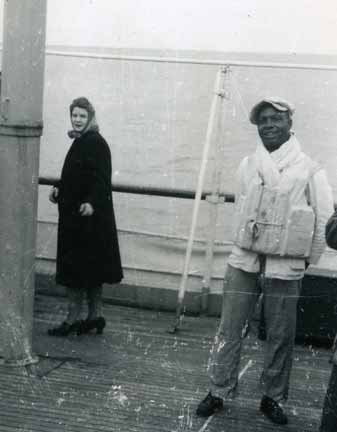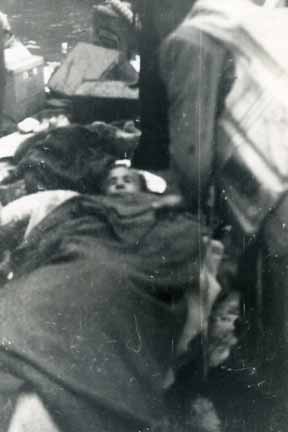Women Mariners in World War II
Clara Gordon Main, a stewardess on the SS President Harrison was among the first American Prisoners of War. The ship was captured by the Japanese on December 7, 1941, while rescuing U.S. Marines from China.
The SS President Harrison, sent from Manila to China to transport a contingent of Marines to the Philippines, was captured in the Yellow Sea when a Jap dive bomber dropped notes demanding surrender. Captain Orel A. Pierson, however, ordered the ship "full ahead."
Knowing there was no chance of escape, Captain Pierson headed his ship for the beach. The President Harrison rammed the shore with a grinding screech and almost turned on her side. The liner righted herself, however, and was carried off the rocks by currents. The order was given to abandon ship.
Japanese Marines stormed aboard the vessel after she'd settled to rest on a mudbank - but it was more than a month before sufficient repairs could be made to enable the captives to take her to Shanghai where the crew was later interned. The crew stayed on the liner and an island for 40 days.
During the capture and for over a month thereafter, Mrs. Clara Main, stewardess aboard the vessel, "displayed a courage and calmness exceeded by no member of the crew. While the bomber power-dived us, threatening the ship with bombs -- Mrs. Main remained, at least outwardly, entirely unexcited."
Mrs. Main is credited with saving the life of Chief Steward J. L. McKay of San Francisco. McKay was in a lifeboat which, before it could be pushed away from the hull, was thrown by current, waves and wind into the ship's screw and broken in half. Three men were killed and several badly injured.
McKay and Mrs. Main were allowed to remain on the island the following day when the Japs ordered the crew back aboard. In a few days they returned to the liner and for six weeks the stewardess nursed McKay back to health. ". . . Without her constant care," it was said, "McKay would not have survived.
[Text and illustrations from April 1944 MAST, the magazine of the U.S. Maritime Service]
Meritorious Service Medal Citation to Clara Gordon Main
"At the outbreak of the war with Japan, SS President Harrison, in which Mrs. Main was serving as Stewardess, was beached on the coast of China by the Master, in an effort to prevent capture by the enemy. The vessel was, however, first bombed and then captured by the Japanese who ordered all hands to abandon ship. In so doing the Chief Steward suffered several broken ribs. Mrs. Main, the only woman member of the large crew, conducted herself in such a cool and collected manner that she had a decidedly steadying influence on the seamen. She also had the foresight to take with her, as she left the ship in the last boat, certain medicinal restoratives and first aid material, which proved invaluable. During the ensuing six weeks she nursed the Chief Steward so effectively that she undoubtedly saved his life. Her calm and courageous attitude, and her skillful nursing, assisted greatly in maintaining the crew's morale, and will be a lasting inspiration to all seamen of the United States Merchant Marine."
Clara Main and unidentified member of SS President Harrison crew await their fate Injured Chief Steward J. L. McKay ashore on the island
More about the President Harrison and POW's
Casualties and Heroes
Mary Cullum Kimbro of Nashville, Tennessee was a Stewardess aboard the SS City of Birmingham which was torpedoed by U-202 on June 30, 1942 about 250 miles east of Cape Hatteras, North Carolina while en route from Norfolk to Bermuda with 263 passengers, 113 crew, and 5 Naval Armed Guard. The ship was hit by two torpedoes and sank within 5 minutes. The USS Stansbury rescued 372 survivors; 2 passengers and 7 crew members were lost.
[SS City of Birmingham at right from A Careless Word... by Arthur Moore]
Winifred Grey of New Orleans, Louisiana was one of 10 crew members lost on the SS Robert E. Lee when she was torpedoed by U-166 on July 30, 1942 about 25 miles from the Mississippi delta while in covoy from Trinidad to New Orleans. The ship sank within 15 minutes. She had 131 crew members, 6 Naval Armed Guard, and 270 passengers, most of whom were survivors of previously torpedoed American ships. 15 passengers were lost.
Mrs. Edna T. Johansson, the first female recipient of the Merchant Marine Combat Bar with Star, was a stewardess aboard the liner SS Sixaola. The SS Sixaola was en route from the Canal Zone to New Orleans, Louisiana, via Guatemala carrying Army trucks and cargo on June 12, 1942 with 87 merchant marine crew, 6 Armed Guard, and 108 passengers. Two minutes after being struck by two torpedoes Captain William H. Fagan ordered the ship abandoned.
29 crew members died in the explosions. After all survivors were aboard 5 lifeboats and 6 rafts, the ship's boiler exploded. The U-159 questioned the crew about the ship and its cargo. Some of the survivors were rescued by the SS Carolinian, USS Niagara, and Army Tug Shasta. 42 others in one lifeboat made Panama in 4 days.
Carmen Maria Quinonez. On Maritime Day, May 22, 1942, New York Mayor Fiorello LaGuardia took part in ceremonies honoring members of the National Maritime Union who had been torpedoed or who were acknowledged as heroes. Among those honored was stewardess Miss Carmen Maria Quinonez, who guided "a woman and three small children to safety when their vessel was torpedoed. After leaving the vessel she administered first aid to three injured passengers in a lifeboat."
Unknown stewardess aboard SS Barbara torpedoed on March 7, 1942 off the north coast of Haiti. The SS Barbara, built in 1913, was zigzagging unarmed, carrying passengers from Baltimore to San Juan, Puerto Rico. On the third day, the raft with 16 men and the stewardess, whom they affectionately called "Grandma," was rescued by a PBY flying boat. The Navy officer who risked two landings and overloaded his plane was cited for the act.
Correction: Dolores Martinez, formerly listed here was male, not female!
Government Limits Women's Service
When passenger ships were taken over by the government after the U.S. entered World War II, many women who had served as stewardesses, hairdressers, etc. lost their jobs. They were required to quit after their ships returned to port after December 7, 1941. One of these women, Betty Jackson, wrote to President Roosevelt: "We are not afraid of the dangers and we are willing to put up with any inconvenience as long as we can be reinstated and go back to sea." Admiral Land, head of the U.S. Maritime Commission replied that there were no provisions on wartime ships for women crewmembers.Admiral Emory Land, head of the Maritime Commission and War Shipping Administration also received a visit from 20 women headed by a "blonde with a very short skirt and bare legs" who argued for the right to go to sea, since among other reasons, one Russian skipper was a woman. Admiral Land finally told these ladies of "mixed nationalities including a couple of coloured women" that the question of their morals must be considered." The blonde leader replied, "Damn you, Admiral. You take care of your morals and we'll take care of ours."
Miscellaneous About Women
One World War II Radio Operator remembers that while home on leave in July 1943, a female high school classmate wanted to join the Merchant Marine as a radio operator, but was refused. He remembers meeting Scandinavian women radio operators in the Panama Canal in 1944.One Radio Operator met a female Radio Operator while being briefed on communications procedures during a convoy conference in Port Said, Egypt in 1944. She was the sole Operator aboard a Norwegian flag tanker. "We were both headed for the Persian Gulf...we, with a load of Russian bound materiel, and her, to load oil."
Many Soviet ships had women crew members, including the Soviet tankers which were part of Convoy PQ-17.
Sources:
MAST, April 1944
"Mayor Bestows Medals on Heroic Seamen; Praises Merchant Crews for Valor in Wartime." New York Times. May 23, 1942
Moore, Arthur R. A Careless Word - A Needless Sinking: A History of the Staggering Losses Suffered by the U.S. Merchant Marine, both in Ships and Personnel, during World War II. American Merchant Marine Museum, Kings Point, NY: 1998
Hughes, Terry and Costello, John The Battle of the Atlantic. New York: Dial Press,1977
Bunker, John G. Liberty Ships, The Ugly Ducklings of World War II. Annapolis, Maryland: Naval Institute Press, 1972
Photos from SS President Harrison courtesy Lee Muller, son of Clayton Muller01/05/04 Revised 04/26/12
www.USMM.org ©1998 - 2012. You may quote material on this web page as long as you cite American Merchant Marine at War, www.usmm.org, as the source. You may not use more than a few lines without permission. If you see substantial portions of this page on the Internet or in published material please notify usmm.org @ comcast.net

